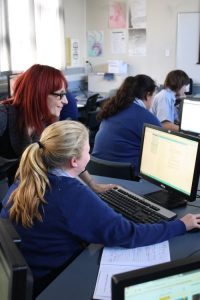
At Rosehill College, all students will benefit from the extra learning opportunities that a digital device will create and hence the school sees it as a necessary learning tool.
Each student’s device will need to connect to the Rosehill College wireless network and some devices will be better suited to this task than others. Rosehill College recommends a Chromebook as a functional and affordable tool that will give the student access to Google applications which teachers use to manage resources, lessons, and assessments. Other devices such as laptops and tablets will work within our IT infrastructure.
The following minimum specifications for a Chromebook are recommended:
- Memory Size: 2GB
- Screen Size: 11.6 inches
- Screen resolution: 1366×768
- SSD or HDD capacity: 16GB
- Operating System: Chrome OS
Chromebooks are a browser-based technology that provides users access to the web through the Google Chrome browser. This provides all teachers and students with access to the suite of Google tools, including:
- Gmail: Email service
- Classroom: software for receiving and submitting classwork
- Drive: cloud-based office productivity software (documents, spreadsheets, calendar, forms)
- Meet: hold online video conferences
- Sites: website creation software
- YouTube: Video service
eLearning at Rosehill College:
Rosehill College is enthusiastic about the opportunities that eLearning offers our students. We acknowledge that the world is changing and that opportunities for different learning and teaching approaches have been created through the rapid development of technologies worldwide.
The New Zealand Curriculum explicitly states that our vision is to foster young people who will be “confident, connected, actively involved and lifelong learners” (NZC, 2007). The New Zealand Curriculum’s Technology learning area strengthens the positioning of digital technologies in the New Zealand Curriculum to ensure that all learners have the opportunity to become digitally capable individuals. This provides a greater focus on students building their skills so they can be innovative creators of digital solutions, moving beyond solely being users and consumers of digital technologies. “The digital curriculum is about teaching children how to design their own digital solutions and become creators of, not just users of, digital technologies, to prepare them for the modern workforce.”
The Benefits of BYOD:
Many advantages students are bringing their own devices to support their educational needs. A student-owned internet capable device can be an important part of a student’s educational toolkit, providing them instant access to unlimited resources and enabling them to support, extend, communicate and share their learning in ways that are evolving and improving.
Some of the benefits of BYOD include:
- Students learn to manage files and resources for their classes through cloud computing.
- Students engage in online communication with teachers, parents and peers to support their learning.
- Anywhere-anytime access to targeted and broad resources and information.
- Active learning partnerships and collaborations in synchronous and asynchronous environments.
